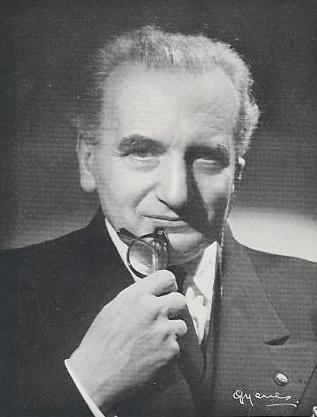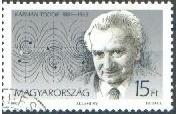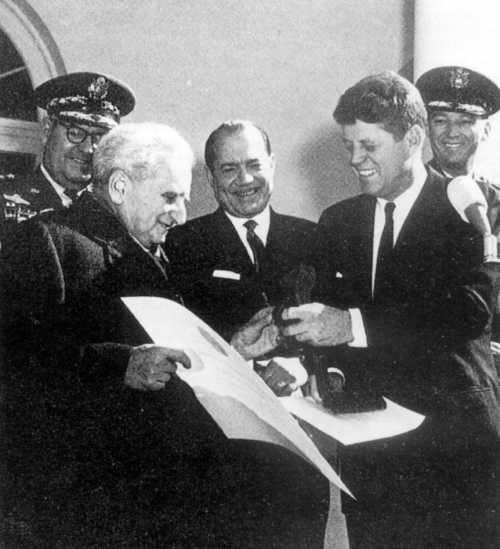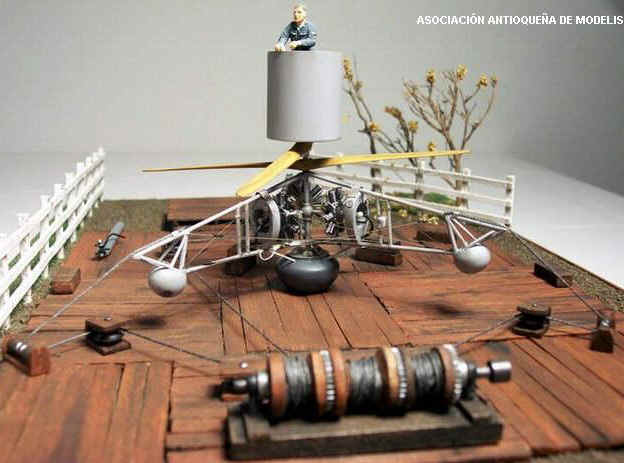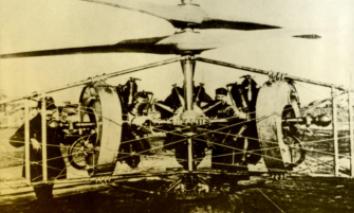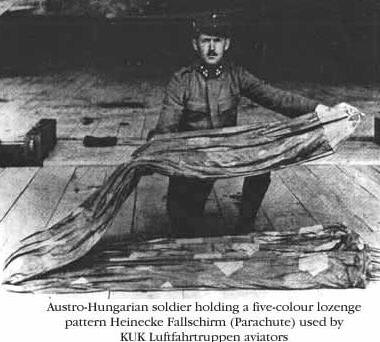|
LA SECONDA GUERRA MONDIALE
|
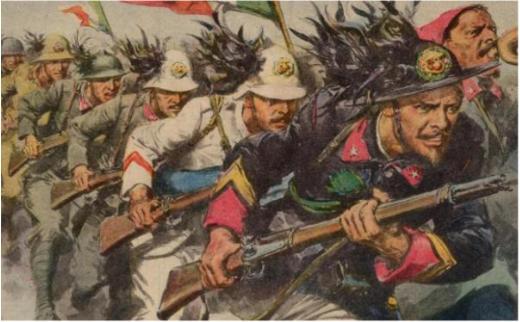 |
Il frullatore Karman
|
|
Theodor von Karman (1881-1963)
He took his baccalaureate at the Main Grammar School (today’s Trefort Street Grammar School) founded by his father, famous educator and educational politician Mór Kármán (1843-1915). He went on to attend the József Technical University, taking a degree in mechanical engineering in 1902. In 1906, he travelled to the University of Göttingen on a scholarship from the Hungarian Academy of Sciences. It was there that he developed his analysis of the alternating double row of vortices behind a bluff body (one having a broad, flattened front) in a fluid stream. In science this phenomenon is called Karman’s Vortex Street. In 1912, he became head of department at the Technical University of Aachen. His professorship was interrupted by WWI. During the war he developed the world’s first military helicopter (PKZ helicopter) in cooperation with aviation engineers István Petróczy and Vilmos Zurovecz. * |
|
|
Nel 1963 gli viene riconosciuta la più alta onorificenza scientifica Americana, la Medaglia Nazionale della Scienza, dalle mani del Presidente degli Stati Uniti (Kennedy) per meriti in campo missilistico (e non si parla di Von Braun, del tedesco, che li tirò fuori dai pasticci lui che di missili si che se ne intendeva). |
Ognuno di noi che svolge ricerche lunghe e meticolose, per non tralasciare nulla, rimane molto deluso quando, messo tutto on line a disposizione del pubblico, salta fuori una piccola scatola di montaggio nel negozio di modellismo, diciamo sotto casa che frequenti da sempre, con il "vero" elicottero, quello che ha "veramente" volato in anni lontani (prima guerra mondiale così diceva la scritta). Scatola con disegni, progetti, foto e un foglio allegato col nome dei costruttori. Si chiamava Pkz 2. Ci fosse stata una volta che quella macchina infernale di Google l'avesse sputata. Ad un più attento esame del foglio di accompagnamento della scatola si capisce che proprio un elicottero non era. Assomigliava molto ad un gioco per ragazzi che si carica con una molla e, tenuto con una corda, si alza in volo, facendo attenzione a che non si impigli in alberi o fili della luce. Il signor Karman (la Kappa della sigla), di cui trovate a fianco un profilo biografico, uomo pluripremiato, di cultura tedesca (son sempre tedeschi gli scienziati?), si mise in società con altre due persone, Petróczy e Zurovecz, per sostituire i pericolosi palloni aerostatici da osservazione della Grande Guerra. Salire su un pallone frenato alla mercè di aviatori cacciatori (se ne tornavano spesso a casa con la tela del pallone sulle ali), senza possibilità di fuga e di difesa, era un mestiere veramente pericoloso, pericoloso ma non tanto quanto Karman stava per servirgli. Con le cognizioni già acquisite applicò il principio della pala (o doppia pala) ruotante nell’aria, per sostenere un cesto da osservatore e i relativi motori per le pale. Il tutto ancorato a terra con un maxi rocchetto (la spoletta del filo del sarto). Limitazione: non c'erano manovre attive o passive. Non sembra ma trovarono anche dei volontari per sperimentarlo, ma diversi incidenti dissuasero dal portare a termine il progetto. La guerra d’altronde stava finendo, e anche male, per loro. | |
|
|
After the war he returned to Aachen, where he worked until 1930. He was founder and head of the Institute of Aerodynamics, soon to become a research centre for aviation science. In the meantime he delivered lectures in Pasadena (USA), Finally in 1933 he settled in the USA, where he joined the rocket research team at the Guggenheim laboratory. He had major share in the design and production of many large rockets and in the world's first ballistic missile. There he solved several fundamental problems of supersonic aviation. In 1936, he established a missile research department, which became an independent institute named the Jet Propulsion Laboratory in 1944. The U.S. Army’s first ballistic missile was developed here. Karman solved the technical problem of supersonic aviation and he is considered to be one of the pioneers of missile technology. From 1951 on, he was president of AGARD, the Aviation Research and Development Institute of NATO. In 1962, he was awarded an honorary doctor’s degree by the Technical University of Budapest. In 1963, he received the highest American scientific award, the National Medal of Science, from the President of the United States (Kennedy). Craters on the Moon and Mars have been named in his honour. | |
|
|
** Stephan (Istvan) Petrochy, Vilmos Zurovecz. and Professor Theodore von Karman, built and flew a coaxial rotor helicopter during the closing years of WWI. Intended for observation, this machine included a pilot/observer position above the wooden counter-rotating rotors, inflated bags for landing gear, and a quick-opening parachute. Petrochy proposed the idea of replacing observation balloons by a new-type of machine. He suggested that a helicopter would be more reliable and less dangerous then hydrogen filled balloons. Three 120-horsepower (89-kilowatt) rotary engines provided power. The machine achieved. Stephan Petroczy and Theodore von Karman designed a captive helicopter for observation, not transportation. The craft had two coaxial rotors and was powered with three 120-hp (89-kW) LeRhone engines. Although it rose to a height of 164 feet (50 m) and remained aloft for an hour, it was always held by cables and could not move horizontally. Yet during 1916 Major Stephan.Initially the new helicopter was planned with the installation of the 300 hp electric Austro Daimler motor, but this decision proved wrong because of it being too heavy. | |
|
|
In its final configuration the PKZ-2 ("PKZ" for Petrochy-Karman-Zurovec whose ideas and decisions gave a life to helicopter) was a counter-rotating machine with two rotors and three 100 hp Gnome rotary engines; construction was light and assembly easy for transportation purposes. The PKZ-2 was a "tethered" helicopter, with tethering cables retracted by winches on the ground. The observer occupied a special cupola-like basket; he could leave the cupola with a parachute, if necessary. Test flights of the PKZ-2 began in April of 1918. The more powerful Le Rhone's soon replaced the unreliable Gnome's. The helicopter performed more than 30 successful flights, but some problems with stability were still unsolved. On June 10, 1918 the PKZ-2 was demonstrated for military commanding officers; two flights were made with observers in the basket, but others were made without an observer. On the same day the helicopter crashed from height and was slightly damaged. Military command refused the PKZ-2, saying it represented a "high danger to the observer". On June 21st 1918 the project was cancelled. Finally, the PKZ-2 was a revolutionary design for its time. Only forty years later the counter-rotating scheme was introduced on the Kamov helicopters in the Soviet Union: other countries generally would not adopt this scheme. And although the PKZ-2 was never used operationally, it really was the first real helicopter and the only helicopter, which flew in the skies of World War One. | |
| ** piccola traduzione: Coi due compagni austriaci, il Professor Karman costruisce un elicottero a rotori coassiali nell'ultimo anno di Guerra (1917/8) ad uso degli osservatori di artiglieria. Questa macchina ha una postazione per il pilota/osservatore e altri aggeggi non ultimo un paracadute per lanciarsi (i paracadute non erano per i piloti d'aereo). Petrochy con questa macchina intendeva sostituire i palloni da osservazione ad elio, pericolosi per il gas che usavano. Un elicottero secondo lui sarebbe stato più funzionale. Tre motori elettrici rotanti da 120 cavalli di potenza (89-kilowatt) davano la spinta ascensionale. L’uso era solo per osservazione e non poteva trasportare bombe o altro. Il mezzo salito a un'altezza di 164 piedi (50 m) sulla verticale dell'impianto di terra è rimasto nell'esperimento sollevato per un'ora, ma è stato sempre tenuto da terra con cavi ( non poteva muovere orizzontalmente). Si cercò anche di installare motori elettrici Daimler da 300 HP, ma questo rese il tutto ancora più pesante. La versione finale o Pkz 2 venne provvista di due rotori e tre motori da 100 HP Gnomo. La costruzione risultò leggera ed il montaggio relativamente semplice. Il PKZ-2 era un elicottero "tethered", cioè tenuto col filo. L'osservatore occupava un canestro che poteva abbandonare, se necessario, con un paracadute (pale permettendo, ma se ci si buttava era forse perchè le pale s'erano arrestate !!!). L’inizio dei voli sperimentali parti nell’aprile 1918. Il più potente Rhone (motore) sostituì presto lo Gnomo non affidabile. L'elicottero sostiene con successo più di 30 alzate, ma ha dei problemi con la stabilità orizzontale (anche vento in quota) non controllata che non vengono risolti. Il 10 giugno il PKZ-2 viene mostrato ai comandi militari. Due voli si effettuano con osservatore nel canestro e altri senza (era come se fosse telecomandato, oggi basterebbe montare una telecamera per spiare i movimenti del nemico, l'antenato in pratica degli U2). Un passaggio con operatore a bordo finisce miseramente di fronte agli alti ufficiali. Il PKZ-2 viene rifiutato. La sua tecnologia rivoluzionaria verrà usata 40 anni dopo su un elicottero Russo Kamov. Benché non sia mai stato operativo il Pkz 2 è considerato il primo elicottero che abbia volato nei cieli di guerra. | ||
|
|
* Ha preso la sua licenza liceale alla Scuola di Grammatica fondata da suo padre, famoso educatore e politico magiaro Mór Kármán (1843-1915). Ha poi continuato alla Università Tecnica Józsefl con un diploma in ingegneria meccanica nel 1902. Nel 1906 è andato all'Università di Göttingen con una borsa di studio dell'Accademia Ungherese delle Scienze. E’ lí che ha sviluppato la sua analisi su "the alternating double row of vortices behind a bluff body (one having a broad, flattened front) in a fluid stream". In campo scientifico questo fenomeno è chiamato Karman’s Vortex Street. Nel 1912, lo troviamo a capo dipartimento all'Università Tecnica di Aachen. Il suo insegnamento viene interrotto dalla Grande Guerra. Nel corso del conflitto ha sviluppato il primo elicottero militare al mondo (PKZ) in concorso (assieme) agli ingegneri d’aviazione István Petróczy e Vilmos Zurovecz. Dopo la guerra ritorna a Aachen, dove lavora fino a 1930. Fonda e guida l'Istituto di Aerodinamiche,che diventa in breve un centro di ricerca per la scienza del volo. Svolge conferenze a Pasadena (USA) per poi stabilirvisi definitivamente nel 1933 nel Team dei laboratori Guggenheim sulla ricerca missilistica. Suoi i progetti di molti grandi razzi e del primo missile balistico nel mondo. Ha risolto parecchi problemi fondamentali di aviazione supersonica. Dal 1936 ha un proprio dipartimento di ricerca che nel 1944 prende il nome di "the Jet Propulsion Laboratory". Qui nascono i primi missili balistici dell’ U.S. Army (ma non si dice con chi lavorava). Karman è considerato uno dei pionieri della tecnologia missilistica. Da 1951 in poi è il presidente di AGARD, l'Istituto di Ricerca di Aviazione e Sviluppo della NATO. Alcuni crateri sulla Luna e su Marte portano il suo nome. http://aerodyn.org/People/vonKarman.html | |
|
|

